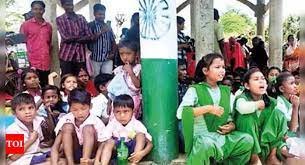At 8 a.m., the small village of Rud in the Latehar district of north-western Jharkhand awakens from its slumber. The government upper primary school becomes a hive of activity as children dressed in white shirts and green skirts or shorts form orderly lines and make their way to the playground. The playground itself is a modest 7×5 metre plot, but it quickly fills up with students ranging from Classes I to VIII. Amidst the growing crowd, a determined figure emerges – Manju Kumari, a 45-year-old woman who assumes the responsibility of not only overseeing the morning assembly but also being the sole teacher for all 145 students.
Ms. Kumari has learned to project her voice loudly enough to ensure that every student can hear her. She understands the importance of making herself heard in a school where she is the only teacher. Her dedication is evident as she takes charge of the assembly, leading the students in singing the national anthem and reciting prayers that fill the air with a sense of unity and purpose.
Unfortunately, Ms. Kumari’s situation is not unique in Jharkhand. She is just one of many teachers who find themselves single-handedly running primary, upper primary, and even senior government schools in the region. Reflecting on her experience, Ms. Kumari recalls that when she joined the school in 2015, there was another teacher who shared the responsibilities with her. However, that teacher later retired, leaving Ms. Kumari as the sole educator in the school. Despite the vacancy created by her colleague’s departure, no replacement teacher – whether on a contractual or permanent basis – was sent to the school.
This lack of support has placed an immense burden on Ms. Kumari’s shoulders. She must teach and cater to the educational needs of 145 students across multiple grade levels, a challenging task even for a well-staffed school. It requires her to be not only a teacher but also an administrator, counselor, and mentor, all rolled into one. Juggling such responsibilities is demanding, and the absence of additional staff leaves Ms. Kumari with little time for personal development or professional collaboration.
The situation faced by Ms. Kumari highlights a larger issue within the education system of Jharkhand. The state struggles with a shortage of qualified teachers, particularly in rural areas. This shortage is often compounded by the lack of infrastructure and resources, making it difficult for students to receive a quality education. The burden placed on teachers like Ms. Kumari not only affects their well-being and job satisfaction but also hampers the overall educational experience for the students.
Efforts to address this issue are crucial for the future of Jharkhand’s education system. Recruiting and deploying more qualified teachers to schools in rural areas, providing adequate resources and infrastructure, and investing in professional development programs can help alleviate the burden on teachers and improve the quality of education for students. Only through such comprehensive measures can the potential of Jharkhand’s young minds be fully realized, ensuring a brighter future for the state and its residents.


